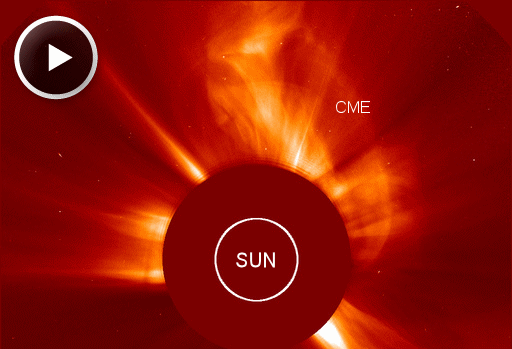They came from outer space--and you can have one! Genuine meteorites are now on sale in the Space Weather Store. | | |
SUBSIDING STORM: The intense geomagnetic storm of Oct. 24-25 (described below) has subsided and US skies are returning to normal. If you missed the show, don't worry. The Northern Lights will be back. For much of the past few years, the sun has been in a quiet state; but solar activity is cyclical and the sun appears to be waking up again. Forecasters expect new Solar Cycle 24 to peak in 2012-2013 with many more chances to see auroras in unfamiliar places. Aurora alerts: text, voice.
AURORAS IN THE USA: A coronal mass ejection (CME) hit Earth on Oct. 24th at approximately 1800 UT (2:00 pm EDT). The impact strongly compressed Earth's magnetic field, directly exposing geosynchronous satellites to solar wind plasma, and sparked an intense geomagnetic storm. As night fell over North America, auroras spilled across the Canadian border into the contiguous United States. A US Department of Defense satellite photographed the crossing:

"This shows the auroras on Oct. 25th at 0140 GMT," says Paul McCrone of the Fleet Numerical Meteorology and Oceanography Center in Monterey, California. He created the image using visual and infrared data from the Defense Meteorological Satellite Program's F18 polar orbiter. DMSP satellites carry low light cameras for nightime monitoring of moonlit clouds, city lights and auroras. Some of the auroras recorded by the F18 on Oct. 25th were as bright as the city lights underneath.
This "big picture" from orbit makes sense of what happened next. The bright band swept south and, before the night was over, auroras were sighted in more than thirty US states: Alabama, Wisconsin, New Mexico, Tennessee, Missouri, Illinois, Nebraska, Kentucky, North Carolina, Indiana, Oklahoma, Kansas, Iowa, Maryland, New York, Montana, Ohio, Colorado, Pennsylvania, Washington, Virginia, Texas, Arizona, Minnesota, Maine, Michigan, Montana, Oregon, Arkansas and California.
Many observers, especially in the deep south, commented on the pure red color of the lights they saw. These rare all-red auroras sometimes appear at low latitudes during intense geomagnetic storms. They occur some 300 to 500 km above Earth's surface and are not yet fully understood.
UPDATED: October 2011 Aurora Gallery
[previous Octobers: 2010, 2009, 2008, 2007, 2006, 2004, 2003, 2002]
THE INSTIGATING EXPLOSION: The CME that hit Earth's magnetic field on Oct. 24th left the sun almost two days earlier. It was propelled in our direction by an unstable magnetic filament, which erupted around 0100 UT on Oct. 22nd. This movie from the Solar and Heliospheric Observatory shows the cloud expanding toward Earth in the first hours after the explosion:

Traveling faster than two million mph, the cloud took about 41 hours to cross the sun-Earth divide. The CME was so geoeffective because it contained a knot of south-pointing magnetic fields. These fields partially cancelled Earth's north-pointing magnetic field at the equator, allowing solar wind plasma to penetrate deeply into Earth's magnetosphere. The rest, as they say in Alabama, is history.

